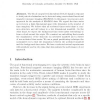Free Online Productivity Tools
i2Speak
i2Symbol
i2OCR
iTex2Img
iWeb2Print
iWeb2Shot
i2Type
iPdf2Split
iPdf2Merge
i2Bopomofo
i2Arabic
i2Style
i2Image
i2PDF
iLatex2Rtf
Sci2ools
67
Voted
IPMI
2005
Springer
2005
Springer
Analysis of Event-Related fMRI Data Using Diffusion Maps
The blood oxygen level-dependent (BOLD) signal in response to brief periods of stimulus can be detected using event-related functional magnetic resonance imaging (ER-fMRI). In this paper, we propose a new approach for the analysis of ER-fMRI data. We regard the time series as vectors in a high dimensional space (the dimension is the number of time samples). We believe that all activated times series share a common structure and all belong to a low dimensional manifold. On the other hand, we expect the background time series (after detrending) to form a cloud around the origin. We construct an embedding that reveals the organization of the data into an activated manifold and a cluster of non-activated time series. We use a graph partitioning technique?the normalized cut to find the separation between the activated manifold and the background time series. We have conducted several experiments with synthetic and in-vivo data that demonstrate the performance of our approach.
Background Time Series | IPMI 2005 | Low Dimensional Manifold | Medical Imaging | Non-activated Time Series |
| Added | 16 Nov 2009 |
| Updated | 16 Nov 2009 |
| Type | Conference |
| Year | 2005 |
| Where | IPMI |
| Authors | François G. Meyer, Xilin Shen |
Comments (0)

